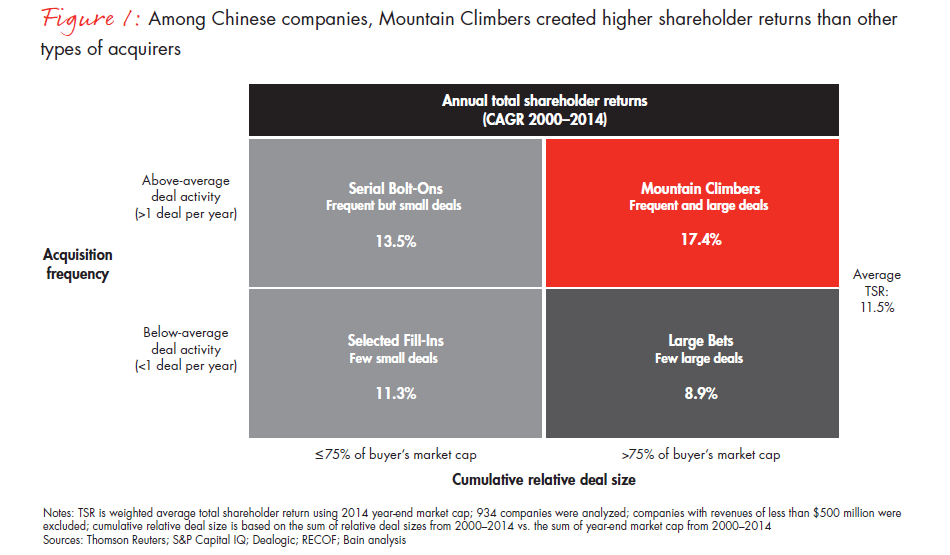Brief

Armed with abundant capital, the government’s encouragement and a willingness to be global, Chinese companies are intensifying their efforts to acquire foreign companies and broadening their capabilities and portfolios to help them win at home and abroad.
China has been a net capital exporter for three years in a row. Bain & Company’s analysis of M&A deal activity shows that the transaction value of outbound deals has been rising by 22% annually since 2009, reaching $79 billion in 2014. Today’s deals cover an expanding number of industries in all regions. Although private enterprises represent a growing share of outbound activity, the largest deals still involve state-owned enterprises. In the past, outbound deals were made primarily with the purpose of obtaining natural resources or raw materials. Today, they’re just as likely to be aimed at helping companies train and develop staff, or giving companies access to overseas revenues and profit pools they’ve not yet addressed.
Many Chinese acquirers are new to this game. As they turn to outbound M&A, they need to learn some fundamental rules to avoid common missteps (see below, "Questions to guide outbound M&A"). When outbound deals fail to deliver, acquirers typically stumble over three hurdles. First, they may overlook the importance of scenario analysis and may be ill-prepared for unexpected macroeconomic risks such as currency fluctuations or commodity price cycles. Second, they may shortcut the due diligence process. The nagging reality is that Chinese buyers tend to undervalue the importance of diligence. We’ve seen companies devote only a single month to diligence, relying primarily on internal staff who are experienced only in the Chinese market. Finally, many Chinese companies struggle with two critical areas of merger integration: culture and governance. For example, it is not unusual for Chinese acquirers to instinctively leave intact a foreign company’s leadership team without exploring the options. That may have been the right move when acquiring a natural resource asset, but when the goal is generating synergies, it could backfire.
Based on our work helping Chinese companies develop their approaches to M&A, we have identified five important rules for success.

Lessons from China: Outbound M&A
Armed with abundant capital, the government’s encouragement and a willingness to be global, Chinese companies are intensifying their efforts to acquire foreign companies and broadening their capabilities and portfolios to help them win at home and abroad.
Make M&A an extension of your growth strategy worldwide. As some Chinese companies are discovering, inorganic growth often is the best answer for creating shareholder value. We’ve learned that the more a company makes M&A a part of its playbook, the more successful its deals become. Our research determined that in China, as in the rest of the world, the bigger and more frequent the deals, the higher the returns to shareholders. Companies that make large-scale acquisitions (with a cumulative deal size representing more than 75% of its market cap) and frequent deals (more than one per year) outperform companies that occasionally engage in M&A or sit on the sidelines (see Figure 1). We call these successful acquirers “Mountain Climbers.” As a group, Mountain Climbers—such as China Gas, Yanzhou Coal Mining Company and Yunnan Municipal Construction Investment Company—achieved an average annual total shareholder return of 17.4% during the period from 2000 to 2014, compared with 11.3% for companies involved in just a few small deals. (We define total shareholder return as stock price changes assuming reinvestment of cash dividends.)

It’s logical: Companies that make more acquisitions are more likely to identify the right targets, to develop the capabilities required to vet deals better and faster, and to form the organizational muscles to more effectively integrate acquisitions. Essentially, leading acquirers develop Repeatable Models® for M&A. They create learning systems that help them build unique, proprietary sets of M&A skills and capabilities that are deeply rooted in their strategies and applied repeatedly to new deals. They sustain institutional investments in their M&A capabilities, much as if they were building a marketing or manufacturing function from scratch.
Clarify how each deal creates value. Every merger or acquisition needs a well-thought-out deal thesis—an objective explanation of how the deal enhances the company’s core strategy. The thesis spells out how the deal will add value to the target and the acquirer. For example, the deal may expand the acquirer’s capabilities, create new opportunities for existing capabilities, generate significant cost synergies or give the acquirer access to new markets. Early development of a meaningful deal thesis derived from a company’s strategy pays off. We recently interviewed 250 executives from around the world and found that 90% of successful deals started with such a thesis, compared with 50% of failed deals. A clear deal thesis identifies the 5 to 10 most important sources of value—and danger—and points you in the direction of the actions you must take to be successful.
Consider the solid deal thesis behind the acquisition of Nedschroef, a leading automotive fasteners supplier in Europe, by the Shanghai Prime Machinery Company (PMC). The deal thesis spelled out how the merger would enable PMC to enter a high-barrier market segment that would have been difficult for the company to access on its own. And Nedschroef would have access to the fast-growing Chinese market and lower-cost manufacturing.
For many acquirers, viewing a deal through the lens of scale vs. scope yields critical insights about the long-term value of a potential acquisition. Scale deals involve a high degree of business overlap between target and acquirer, fueling a company’s expansion in its existing business. In scope deals, the target is a related but distinct business, enabling the acquirer to enter a new market, product line or channel.
Perform rigorous due diligence. It’s no secret that poor due diligence is the single-biggest cause of unsuccessful deals in China. Among the reasons are inexperience in diligence, overreliance on banks, a lack of understanding of local markets and cultural gaps between China and foreign markets. When Shuanghui International Holdings (now WH Group) acquired Smithfield Foods, the world’s largest pork producer, the 2013 deal was heralded as a potential win-win that would allow the companies to benefit from upstream resources, premium branding opportunities and experience sharing. Unfortunately, the deal failed to meet those lofty expectations. One of the reasons: It was the victim of insufficient due diligence. The companies, for example, did not fully test their upside assumptions; they overestimated the potential to import supply from the US and underestimated the volatility in hog prices in the US and China.
Compare that with the winning approach taken by PMC. The company invested in a comprehensive diligence effort for its acquisition of Nedschroef, setting up dedicated team resources, hiring external advisers, pressure testing scenarios for both core and new markets, and identifying concrete synergies.
As China’s economy has slowed, the country’s outbound M&A activity has soared. Phil Leung, a partner with Bain's Mergers & Acquisitions practice, discusses how more selective, sophisticated M&A strategy can drive economic growth.
Know what you really need to integrate. Many outbound deals go off course for predictable reasons. Without clearly defining the sources of value, companies focus integration efforts on the wrong areas and fail to generate synergies. By not addressing governance, cultural issues and organizational anxiety early on, companies lose key people. Moreover, companies allow the complexity of integration to distract management from the base business.
Integration should start with the unique deal thesis, with integration task forces structured around the key sources of value. Teams need to understand the value for which they are accountable and should be challenged to produce their own bottom-up estimates of value, right from the start.
Companies must resolve the thorniest cultural, people and governance issues quickly and productively, relying on local integration teams. There is a marked difference when executives address these inevitable roadblocks to successful integration. According to a global study conducted by Bain, acquirers that proactively tackled cultural issues saw their share prices rise 5.1%, on average, one year after the deal announcement, whereas companies that were not proactive lost share price.
To glimpse excellence in merger integration, look no further than Geely’s $1.5 billion acquisition of Volvo Car in 2010—a deal that enabled Geely to outperform competitors and helped Volvo reverse declining sales. Merger integration was carefully orchestrated to deliver value to both companies. For example, its newly formed China Euro Vehicle Technology center helped the companies codevelop a platform for compact sedans and gave Geely engineers access to the latest technology. The companies cooperated on procurement for commonly used raw materials and components. But to maintain Volvo’s premium image, Geely kept Volvo as a separate unit with its own sales and dealership network. Geely and Volvo also paid significant attention to cultural and governance issues, a key contributor to the deal’s success. In numerous ways, the integration was designed to respect Volvo’s unique culture. The Swedish automaker’s former CEO was invited to join the merged company’s board. Geely allowed Volvo to operate with a high degree of autonomy and maintained close communications with the relevant labor unions in Sweden. By all indications, the deal was a win-win: Geely improved its technological capabilities and brand image, and gained management expertise from Volvo, and Volvo enhanced its relationship with the Chinese government, rebooting growth in China’s market.
Mobilize in a focused manner. To keep integration on track, outbound deals require a proactive and disciplined approach. The most effective integrations employ a decision management office, and integration leaders focus the steering group and task forces on the critical decisions that deliver the most value. They lay out a decision roadmap and manage the organization to a “decision drumbeat” to ensure that each decision is made by the right people at the right time, and with the best available information.
Companies should start by asking leaders of the integration task force to play back the financial and nonfinancial results for which they are accountable, as well as the time frame. That will help them identify the key decisions they must make to achieve results, by when and in what order.
If management allows itself and the organization to get distracted by the integration, the base business of both companies will suffer. The CEO should set the tone, allocate the majority of his or her time to the base business and maintain a focus on existing customers. Below the CEO, at least 90 percent of the staff should be focused on the base business; they should have clear targets and incentives to keep both businesses humming. Companies should take particular care to make customers’ needs a priority and to bundle customer and stakeholder communications, especially when system changes risk confusing customers. To make sure things stay on course, monitor the base businesses closely throughout the integration process.
As outbound M&A becomes a critical tool for Chinese companies, it’s important to take the time to review the process—and to learn from it. Evaluate how well it worked and what you would do differently the next time. Use your findings and discipline from the integration to make future M&A activities more successful. The biggest lesson that Chinese companies will learn in the years ahead is that the more deals they do, the better they will get.

By the numbers: Insurers navigate the digital transition
79% of consumers worldwide say they will use a digital channel for insurance interactions over the next few years.
Questions to guide outbound M&A
Given the complexities and challenges of outbound M&A in China, there’s no option but to be preemptive and focused. That starts by asking and answering these important questions:
Are we acknowledging the unknown? Pursue advanced diligence to avoid overstating synergies. Recognize the possibility of failure and work on a risk-mitigation plan.
Are we starting early enough? Proactively plan for the integration to begin before the deal closes.
Are we adopting the right governance structure and monitoring mechanisms? Even with scope deals, merely relying on board seats to influence and monitor progress is not enough.
Are we integrating with priority and speed? Effectively address cultural issues. Make the tough decisions and communicate early. Identify high-priority integration activities and locate teams accordingly. Manage logistics relentlessly.
Philip Leung is a Bain & Company partner based in Shanghai, where he leads the firm’s Asia-Pacific Mergers & Acquisitions practice. Kiki Yang is a partner based in Hong Kong and a member of Bain’s Mergers & Acquisition practice.
